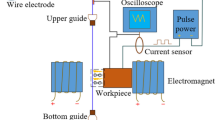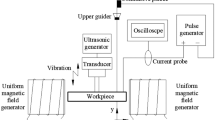Abstract
Magnetic field-assisted low-speed wire electrical discharge machining (MF-assisted WEDM-LS) is an effective technique to improve the surface quality of the workpiece. This paper presents a successive removing model to predict kerf width and the surface topography of nickel–titanium (Nitinol) shape memory alloy in different parameters. Firstly, the motion of an electron was calculated in the magnetic field. It could be obtained that if the length of the discharge channel path was the same with the condition that in traditional WEDM-LS, the width of the discharge gap was decreased because of the deflection of the electron trajectory caused by the magnetic field. Then, a modified gauss heat source equation was derived by calculating the incident angle of the discharge channel. Based on the principle of conservation of energy, the shape of the crater in different parameters was emulated. Moreover, an electrothermal coupling model was established to investigate the surface formation in the successive discharges process. The simulation results show that the average value of the surface roughness of the workpiece in WEDM-LS with magnetic field assisted was decreased by 12.3% compared with that in traditional WEDM-LS. Eventually, experiments of kerf and surface quality were carried out respectively. The experimental results showed that the kerf decreased from 376.2 to 361.7 μm in the magnetic field intensity of 0.4 T. The surface topographies of the workpieces showed good agreement with the simulation results, and the average relative error of surface roughness between simulated results and experimental results is 8.7%.




















Similar content being viewed by others
References
Zupanc J, Vahdat-Pajouh N, Schaefer E (2018) New thermomechanically treated NiTi alloys–a review. Int Endod J 51:1088–1103. https://doi.org/10.1111/iej.12924
Mehrpouya M, Shahedin AM, Dawood SDS, Ariffin AK (2017) An investigation on the optimum machinability of NiTi based shape memory alloy. Mater Manuf Process 32:1497–1504. https://doi.org/10.1080/10426914.2017.1279290
Wang GJ, Liu ZQ, Ai X, Huang WM, Niu JT (2018) Effect of cutting parameters on strain hardening of nickel–titanium shape memory alloy. Smart Mater Struct 27(7):075027. https://doi.org/10.1088/1361-665X/aac43d
Saptaji K, Gebremariam MA, Azhari MAB (2018) Machining of biocompatible materials: a review. Int J Adv Manuf Technol 97:2255–2292. https://doi.org/10.1007/s00170-018-1973-2
Unune DR, Mali HS (2017) Experimental investigation on low-frequency vibration assisted micro-WEDM of Inconel 718. Eng Sci Technol 20(1):222–231. https://doi.org/10.1016/j.jestch.2016.06.010
Sanchez JA, Conde A, Arriandiaga A, Wang J, Plaza S (2018) Unexpected event prediction in wire electrical discharge machining using deep learning techniques. Materials 11(7):1100. https://doi.org/10.3390/ma11071100
Sharma P, Chakradhar D, Narendranath S (2018) Analysis and optimization of WEDM performance characteristics of Inconel 706 for aerospace application. Silicon 10(3):921–930. https://doi.org/10.1007/s12633-017-9549-6
Kumar S, Grover S, Walia RS (2018) Effect of hybrid wire EDM conditions on generation of residual stresses in machining of HCHCr D2 tool steel under ultrasonic vibration. Int J Interact Des Manuf 12(3):1119–1137. https://doi.org/10.1007/s12008-018-0474-8
Das SS, Patowari PK (2018) Fabrication of serpentine micro-channels on glass by ultrasonic machining using developed micro-tool by wire-cut electric discharge machining. Int J Adv Manuf Technol 95(5-8):3013–3028. https://doi.org/10.1007/s00170-017-1441-4
Bains PS, Sidhu SS, Payal HS (2016) Study of magnetic field-assisted ED machining of metal matrix composites. Mater Manuf Process 31(14):1889–1894. https://doi.org/10.1080/10426914.2015.1127953
Zhang GJ, Zhang YM, Chen Z, Li WY, Liu CH (2018) Magnetic-assisted method and multi-objective optimization for improving the machining characteristics of WEDM in trim cutting magnetic material. Int J Adv Manuf Technol 98(5-8):1471–1488. https://doi.org/10.1007/s00170-018-2184-6
Heinz K, Kapoor SG, DeVor RE, Surla V (2011) An investigation of magnetic-field-assisted material removal in micro-EDM for nonmagnetic materials. J Manuf Sci Eng 133:21–29. https://doi.org/10.1115/1.4003488
Tang JJ, Yang XD (2017) A novel thermo-hydraulic coupling model to investigate the crater formation in electrical discharge machining. J Phys D-Appl Phys 50(36):365301. https://doi.org/10.1088/1361-6463/aa7bb7
Jithin S, Raut A, Bhandarkar UV, Joshi SS (2020) Finite element model for topography prediction of electrical discharge textured surfaces considering multi-discharge phenomenon. Int J Mech Sci 177:105604. https://doi.org/10.1016/j.ijmecsci.2020.105604
Izquierdo B, Sanchez JA, Plaza S, Pombo I, Ortega N (2009) A numerical model of the EDM process considering the effect of multiple discharges. Int J Mach Tools Manuf 49:220–229. https://doi.org/10.1016/j.ijmachtools.2008.11.003
DiBitonto DD, Eubank PT, Patel MR, Barrufet MA (1989) Theoretical models of the electrical discharge machining process. I. A simple cathode erosion model. J Appl Phys 66:4095–4103. https://doi.org/10.1063/1.343994
Shabgard MR, Gholipoor A, Mohammadpourfard M (2018) Numerical and experimental study of the effects of ultrasonic vibrations of tool on machining characteristics of EDM process. Int J Adv Manuf Technol 96(5-8):2657–2669. https://doi.org/10.1007/s00170-017-1487-3
Jeswani ML (1978) Roughness and wear characteristic of spark-eroded surfaces. Wear 51(2):227–236. https://doi.org/10.1016/0043-1648(78)90262-4
Davis JR (2010) In: Jin X (ed) Metals handbook. China Machine Press Inc., Beijing, pp 1172–1178
Singh H (2012) Experimental study of distribution of energy during EDM process for utilization in thermal models. Int J Heat Mass Transf 55(19-20):5053–5064. https://doi.org/10.1016/j.ijheatmasstransfer.2012.05.004
Acknowledgements
The authors thanked the Natural Science Foundation of Shanghai for providing the necessary support for the study.
Availability of data and materials
Not applicable.
Author information
Authors and Affiliations
Contributions
Yan Wang: conceptualization, methodology, supervision, writing, review, and editing. Chengzhen Wu: formal analysis and revision. Yongxin Wang: visualization preparation and validation. Liangliang Chu: visualization and figure editing. Wei Xiong: resources and data curation. Jianguo Liu: resources and investigation. Qingzhong Wang: software programming and writing the original draft.
Corresponding author
Ethics declarations
Ethical approval
This work has not been published elsewhere.
Consent to participate
Not applicable.
Consent for publication
Not applicable.
Competing interests
The authors declare no competing interests.
Additional information
Publisher’s note
Springer Nature remains neutral with regard to jurisdictional claims in published maps and institutional affiliations.
Rights and permissions
About this article
Cite this article
Wang, Y., Wang, Q., Xiong, W. et al. Investigation on the kerf and surface formation in the magnetic field-assisted WEDM-LS based on successive discharges. Int J Adv Manuf Technol 114, 841–856 (2021). https://doi.org/10.1007/s00170-021-06906-w
Received:
Accepted:
Published:
Issue Date:
DOI: https://doi.org/10.1007/s00170-021-06906-w




